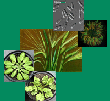| Komor, E; Orlich, G; Weig, A R; Köckenberger, W: Phloem loading - not metaphysical, only complex: towards a unified model of phloem loading, J. Experimental Botany, 47, 1155-1164 (1996) | |
| Abstract: Phloem loading comprises the entire pathway of phloem-mobile solutes from their place of generation (or delivery) to the sieve tubes in a sequence of transport steps across or passing by several different cell types. Each of these steps can be classified as symplastic or apoplastic. The detailed anatomical-cytological work in the past ten years made clear that the symplastic continuity from mesophyll to sieve tubes may be very different for different plant species or even in different vein orders. Therefore data from one species are not transferable to another species and a well-rounded picture involving different experimental methods has to be aimed at for each species separately. The information obtained with the Ricinus seedling, where phloem loading and sieve tube sap analysis can be achieved relatively easily, is presented.The analysis of the radioactive labelling of sucrose from the sieve tubes of cotyledons, in which external and intracellular sucrose had been differently labelled, revealed that at sucrose concentrations close to the natural one, 50% of sucrose is loaded directly from the external medium. The other 50% is first taken up by mesophyll and then released for uptake into the sieve tubes. No bundle tissue works as obligate, intermediate sucrose storage. The apoplast therefore definitely serves as a transit reservoir for sucrose destined to be loaded into the sieve tubes.The sieve tube sap contains glycolytic metabolites at concentrations higher than found in the hypocotyl tissue, whereas the corresponding glycolytic enzymes are missing. It is concluded that the enzymes are sequestered in the companion cell or by parietal membrane stacks.Not only the sieve tubes but nearly all cotyledonary cells are equipped with a sucrose-H+ symporter able to achieve sucrose accumulation and sensitive to inhibition by high salt concentrations or SH reagents. A cDNA clone coding for a sucrose carrier was isolated. It is transcribed at approximately the same level in most organs of the seedling and throughout the germination period. Leaves of adult Ricinus have significantly lower levels of this transcript.Recirculation of excess, phloem-delivered solutes from the sink back to the source is shown not only to be a common feature of long-distance transport, but the only way that an imbalance between supply to and consumption of nutrients in the sink can be adjusted in the source. It is a pathway by which sink activity regulates phloem loading. Non-invasive NMR imaging revealed the flow rates and flow speeds in phloem and xylem in the intact seedling and proved directly the existence of an internal circulating solution flow.A unified model of phloem loading is proposed, based on a pump-and-leak model, where active sucrose carriers (and other carriers) accumulate solutes in the sieve tubes with a concomitant build-up of pressure resulting in mass flow. Plasmodesmata are leaks (as are the transport carriers, too), slowing down the transport rate, but they also serve as diffusion channels for substances which are produced in the neighbouring cell. Therefore, compounds, which are not made in the sieve tubes themselves are translocated together with the bulk solution of sieve tube sap. |

